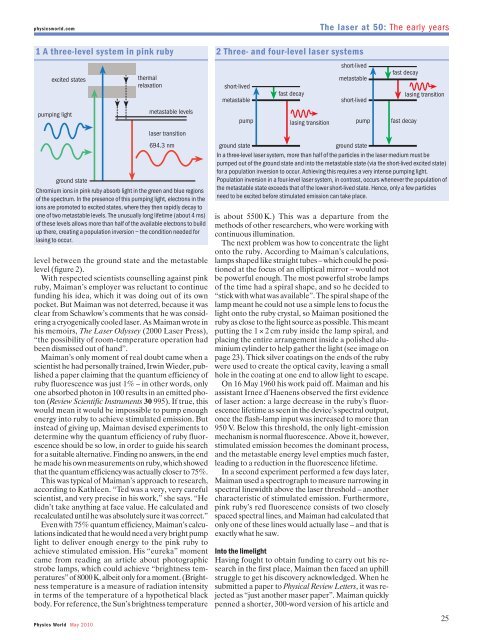special issue
special issue
special issue
Create successful ePaper yourself
Turn your PDF publications into a flip-book with our unique Google optimized e-Paper software.
physicsworld.comThe laser at 50: The early years1 A three-level system in pink rubyexcited statespumping lightthermalrelaxationmetastable levelslaser transition694.3 nmground stateChromium ions in pink ruby absorb light in the green and blue regionsof the spectrum. In the presence of this pumping light, electrons in theions are promoted to excited states, where they then rapidly decay toone of two metastable levels. The unusually long lifetime (about 4 ms)of these levels allows more than half of the available electrons to buildup there, creating a population inversion – the condition needed forlasing to occur.level between the ground state and the meta stablelevel (figure 2).With respected scientists counselling against pinkruby, Maiman’s employer was reluctant to continuefunding his idea, which it was doing out of its ownpocket. But Maiman was not deterred, because it wasclear from Schawlow’s comments that he was consideringa cryogenically cooled laser. As Maiman wrote inhis memoirs, The Laser Odyssey (2000 Laser Press),“the possibility of room-temperature operation hadbeen dismissed out of hand”.Maiman’s only moment of real doubt came when ascientist he had personally trained, Irwin Wieder, publisheda paper claiming that the quantum efficiency ofruby fluorescence was just 1% – in other words, onlyone absorbed photon in 100 results in an emitted photon(Review Scientific Instruments 30 995). If true, thiswould mean it would be impossible to pump enoughenergy into ruby to achieve stimulated emission. Butinstead of giving up, Maiman devised experiments todetermine why the quantum efficiency of ruby fluorescenceshould be so low, in order to guide his searchfor a suitable alternative. Finding no an swers, in the endhe made his own measurements on ruby, which showedthat the quantum efficiency was actually closer to 75%.This was typical of Maiman’s approach to research,according to Kathleen. “Ted was a very, very carefulscientist, and very precise in his work,” she says. “Hedidn’t take anything at face value. He calculated andrecalculated until he was absolutely sure it was correct.”Even with 75% quantum efficiency, Maiman’s calculationsindicated that he would need a very bright pumplight to deliver enough energy to the pink ruby toachieve stimulated emission. His “eureka” momentcame from reading an article about photographicstrobe lamps, which could achieve “brightness tem -peratures” of 8000 K, albeit only for a moment. (Bright -ness temperature is a measure of radiation intensityin terms of the temperature of a hypothetical blackbody. For reference, the Sun’s brightness temperaturePhysics World May 20102 Three- and four-level laser systemsshort-livedmetastablepumpfast decaylasing transitionshort-livedmetastableshort-livedpumpground stateground stateIn a three-level laser system, more than half of the particles in the laser medium must bepumped out of the ground state and into the metastable state (via the short-lived excited state)for a population inversion to occur. Achieving this requires a very intense pumping light.Population inversion in a four-level laser system, in contrast, occurs whenever the population ofthe metastable state exceeds that of the lower short-lived state. Hence, only a few particlesneed to be excited before stimulated emission can take place.is about 5500 K.) This was a departure from themethods of other researchers, who were working withcontinuous illumination.The next problem was how to concentrate the lightonto the ruby. According to Maiman’s calculations,lamps shaped like straight tubes – which could be positionedat the focus of an elliptical mirror – would notbe powerful enough. The most powerful strobe lampsof the time had a spiral shape, and so he decided to“stick with what was available”. The spiral shape of thelamp meant he could not use a simple lens to focus thelight onto the ruby crystal, so Maiman positioned theruby as close to the light source as possible. This meantputting the 1 × 2 cm ruby inside the lamp spiral, andplacing the entire arrangement inside a polished aluminiumcylinder to help gather the light (see image onpage 23). Thick silver coatings on the ends of the rubywere used to create the optical cavity, leaving a smallhole in the coating at one end to allow light to escape.On 16 May 1960 his work paid off. Maiman and hisassistant Irnee d’Haenens observed the first evidenceof laser action: a large decrease in the ruby’s fluorescencelifetime as seen in the device’s spectral output,once the flash-lamp input was increased to more than950 V. Below this threshold, the only light-emissionmechanism is normal fluorescence. Above it, however,stimulated emission becomes the dominant process,and the metastable energy level empties much faster,leading to a reduction in the fluorescence lifetime.In a second experiment performed a few days later,Maiman used a spectrograph to measure narrowing inspectral linewidth above the laser threshold – anothercharacteristic of stimulated emission. Furthermore,pink ruby’s red fluorescence consists of two closelyspaced spectral lines, and Maiman had calculated thatonly one of these lines would actually lase – and that isexactly what he saw.Into the limelightHaving fought to obtain funding to carry out his re -search in the first place, Maiman then faced an uphillstruggle to get his discovery acknowledged. When hesubmitted a paper to Physical Review Letters, it was re -jected as “just another maser paper”. Maiman quicklypenned a shorter, 300-word version of his article andfast decayfast decaylasing transition25



